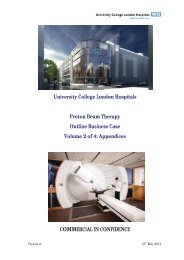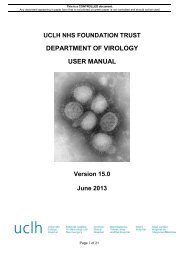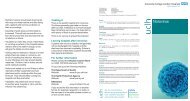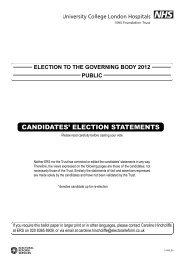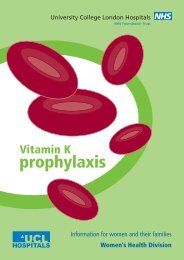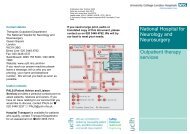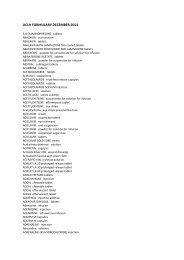Community Nurse Referral PICC Cancer Patients - University ...
Community Nurse Referral PICC Cancer Patients - University ...
Community Nurse Referral PICC Cancer Patients - University ...
You also want an ePaper? Increase the reach of your titles
YUMPU automatically turns print PDFs into web optimized ePapers that Google loves.
<strong>Community</strong> <strong>Nurse</strong> <strong>Referral</strong> Letter (<strong>PICC</strong> Care)<br />
Name of nurse making the referral:<br />
Name…………………………………………Signature…………..………………………………<br />
Date………………Ward…………………………………….Tel 0845 1555 000 Ext………….<br />
Dear <strong>Community</strong> <strong>Nurse</strong><br />
The following patient requires care for a <strong>PICC</strong> (Peripherally Inserted Central Catheter):<br />
Name…………………………..………….…………………….….DOB………………………..….....<br />
Diagnosis……………………………………………………………………………………………...…<br />
Address………………………………………………………………….….…………………………………<br />
……………………………………………………………………………………………………….…<br />
Tel………………………….……..………GP……………………..…..………..……………………….<br />
Please visit as follows………………………………………………………………………………………<br />
…………………………………………………………………………………………………………………<br />
………………………………………………………………………………………………………………….<br />
…………………………………………………………………………………………………………………<br />
………………………………………………………………………………………………………………….<br />
…………………………………………………………………………………………………………………<br />
…………………………………………………………………………………………………………………<br />
…………………………………………………………………………………………………………………<br />
The <strong>PICC</strong> has been checked by X-Ray. If the line is pulled out by more than 5cm please inform<br />
us. As a baseline please note that on discharge the measurement between hub and exit site was<br />
as follows:<br />
Page 1 of 7……continues overleaf<br />
UCL Hospitals is an NHS Foundation Trust incorporating the Eastman Dental Hospital,<br />
Elizabeth Garrett Anderson & Obstetric Hospital, The Heart Hospital, Hospital for Tropical<br />
Diseases, National Hospital for Neurology & Neurosurgery, The Royal London Homoeopathic<br />
Hospital and <strong>University</strong> College Hospital.
…continued. Please note<br />
• We have recently stopped using hepsal for locking lines<br />
• We have recently changed our exit site cleaning regime. We are now using Chloraprep ®<br />
• Dressing change & flush are due weekly: instructions attached<br />
• Blood tests: if required patient will be given blood forms with dates for when the tests are due.<br />
Please take blood from the <strong>PICC</strong> and sent to your usual Path lab. Instructions attached.<br />
• Print off your own copies of the attached information from our website at www.uclh.nhs.uk/cvc<br />
A Note About Infection: Most patients on chemotherapy are immunocompromised and infections should<br />
be acted on immediately.<br />
♦ If the patient experiences a rigor and/or pyrexia following flushing of the line, contact the hospital<br />
urgently. Haematology pts: contact 0845 1555 000 Bleep 1154. Oncology Pts: contact 07947 959 020.<br />
♦ If the exit site is inflamed or there is purulent exudate, please take a swab. If the patient is pyrexial,<br />
contact the hospital urgently as above. If not, this can wait until the next working day. The site should be<br />
inspected daily while infection is suspected and use of Biopatch ® & Chloraprep ® should be<br />
suspended until the infection has resolved.<br />
♦ Handwashing and a non-touch technique are vital: please follow attached instructions.<br />
Tick<br />
<strong>PICC</strong> discharge checklist to be completed by nurse referring patient<br />
Patient supplied with items in List A (see below). Subsequently supplied by community team.<br />
Patient supplied with enough items in List B (see below).<br />
Patient / carer knows to collect items from List B each time they attend the hospital<br />
Copy of this referral to be faxed to you<br />
Hard copy of this referral to be given to patient<br />
Patient knows who to contact if they have a problem with their <strong>PICC</strong><br />
Signed………………………………………………………..Date………………………………<br />
List A<br />
• Dressing pack x 2<br />
• Transparent dressings x 2<br />
• Steristrips x 2<br />
• 10 ml syringes x 10<br />
• Green needles x 10<br />
• Clinell wipes x 10<br />
• 1 box 0.9% saline 10mls (IV use)<br />
• Sharps bin<br />
List B<br />
• Chloraprep Sepp .67mls ®<br />
• Statlock dressings<br />
• Biopatch ®<br />
• Bionectors<br />
• Large yellow bags x 2 for disposal of<br />
chemo (if required)<br />
Page 2 of 7……continues overleaf<br />
For advice or to arrange teaching contact Central Venous Access Team<br />
Tel: 0845 1555 000 ext 77491. Email: centralvenousaccess@uclh.nhs.uk
Flushing a <strong>PICC</strong><br />
<strong>Community</strong> nurse referral for <strong>PICC</strong> Care page 3 / 7<br />
• Our <strong>PICC</strong>s are fitted with Bionectors rather than bungs. These are needle-free access ports. YOU<br />
SHOULD NEVER STICK NEEDLES INTO them, and they need to be changed once a week.<br />
• Please treat each lumen separately, using a different syringe for each lumen.<br />
• Most of our <strong>PICC</strong>s do not have clamps because each lumen has a valve which keeps air from<br />
entering when the Bionector is changed.<br />
Routine Flushing: weekly for unused lumens.<br />
1. Wash hands. Draw up saline into syringes.<br />
2. Clean end of Bionector with 2% chlorhexidine swab. Rub<br />
vigorously for 30 seconds using different parts of the swab.<br />
3. Allow to dry fully without becoming contaminated (OR if<br />
Bionector change is due, remove Bionector, clean end of lumen<br />
with alcohol swab, allow to dry, apply new Bionector and proceed.)<br />
4. Remove needle from saline syringe. Push the syringe into the<br />
Bionector and twist clockwise. The syringe should now stay in place.<br />
Equipment Needed<br />
per lumen<br />
• 10 mls 0.9% Saline IV<br />
• 10 ml syringe (no<br />
smaller)<br />
• Needle<br />
• 2% Chlorhexidine in<br />
alcohol swabs<br />
• Sterile towel<br />
• Spare Bionector if<br />
change due<br />
5. Flush the <strong>PICC</strong> using a brisk “push-pause” technique (ie pause after each ml: this creates turbulence<br />
in the line and helps clear any tiny debris). DO NOT FORCE THE FLUSH or you may split the <strong>PICC</strong>.<br />
If you meet resistance, STOP and contact the hospital for advice. Never use a smaller syringe to try to<br />
unblock the <strong>PICC</strong>.<br />
6. Remove syringe by twisting anti-clockwise while flushing in the last ml of saline. Leave Bionector in<br />
place.<br />
Taking blood from a <strong>PICC</strong>.<br />
Equipment Needed<br />
As for routine flush (above) but add:<br />
• two extra empty 10 ml syringes (or<br />
one extra syringe plus Vacutainer<br />
connector)<br />
• 2 x 10ml syringes of saline and a<br />
spare in case <strong>PICC</strong> needs flushing<br />
before it will bleed back.<br />
1. Access the <strong>PICC</strong> using aseptic<br />
technique as for flushing.<br />
2. Withdraw & discard first 4mls of blood<br />
from <strong>PICC</strong>. (If it won’t bleed back try<br />
flushing the line first or ask patient to<br />
take deep breaths.)<br />
3. Take the blood sample.<br />
4. Flush immediately with 2 x 10mls 0.9%<br />
saline: turbulent push-pause flush.<br />
Further info: Print off your own copy at<br />
www.uclh.nhs.uk/cvc. Contact <strong>Nurse</strong><br />
Specialists: Tel: 0845 1555 000 x77491.<br />
Email:centralvenousaccess@uclh.nhs.uk<br />
Out of hours: Haematology patients<br />
contact 0845 1555 000 Bleep 1154.<br />
Oncology patients contact 07947 959 020.<br />
Updated by Liz Simcock October 2009<br />
If you are flushing off chemotherapy…<br />
Chemotherapy can damage cells. Avoiding contact with<br />
chemotherapy is like avoiding radiation in an X-ray<br />
department. Repeated exposure can be harmful. This is<br />
why it must be handled with care.<br />
• Always wear apron and gloves when handling lines,<br />
bags and infusion devices containing Chemotherapy<br />
• Disconnect the giving set from the <strong>PICC</strong> leaving the<br />
Bionector in place.<br />
• Avoid dripping or splashing of the Chemotherapy.<br />
• Dispose of contaminated equipment carefully in a<br />
double yellow bag including the empty infusion device,<br />
the syringe used to flush the line through and your<br />
gloves and apron<br />
• The yellow bag can be brought back to the hospital by<br />
the patient at his / her next visit for disposal by the<br />
chemotherapy nurses. In the meantime it should<br />
always be stored out of the reach of children.<br />
• Always wash your hands on removing your gloves and<br />
apron.<br />
In the event of a spillage<br />
Chemotherapy can cause irritation if it comes into direct<br />
contact with the skin. If for any reason this should happen,<br />
flush the affected area with plenty of water and a mild<br />
soap. If any burning or rash develops subsequently, seek<br />
medical advice.
Chloraprep and Biopatch<br />
<strong>Community</strong> nurse referral for <strong>PICC</strong> Care page 4 / 7<br />
Chloraprep Sepp .67mls ® is a single-use sterile applicator containing a 2% solution of Chlorhexidine<br />
Gluconate and 70% Isopropyl Alcohol. It’s coverage area is 5cm x 8cm.<br />
• It works by penetrating the top 5 layers of the skin where most bacteria is found.<br />
• At UCLH <strong>Cancer</strong> Services and Adolescent <strong>Cancer</strong> we are now using Chloraprep ® for cleaning all our<br />
Central Venous Catheter exit sites including <strong>PICC</strong>s.<br />
Can it be used for all patients?<br />
• <strong>Patients</strong> must be aged 2 months and over.<br />
• Adverse reactions are very rare but can cause anaphylaxis. Do not use on patients with a history of<br />
hypersensitivity to Chlorhexidine.<br />
How should it be used?<br />
• Pinch the sides of the applicator once (in the middle of the ampoule) until you feel the<br />
inner ampoule break. The antiseptic solution will soak the sponge tip.<br />
• Use a gentle repeated back-and-forth friction rub for 30 seconds and allow to dry<br />
completely.<br />
• Discard in clinical waste bag.<br />
• If there is loose blood or exudate around the exit site, clean this away using 0.9%<br />
saline before using Chloraprep ® .<br />
Biopatch ® is a disc-shaped foam dressing impregnated with Chlorhexidine<br />
Gluconate. Biopatch ® inhibits bacterial growth.<br />
• At UCLH we are now using it on all our Central Venous Catheter exit sites<br />
including <strong>PICC</strong>s (except for patients under the age of 16).<br />
Can it be used for all patients?<br />
• <strong>Patients</strong> must be aged 16 or over.<br />
• Adverse reactions are very rare but can cause anaphylaxis. Do not use on patients with a history of<br />
hypersensitivity to Chlorhexidine.<br />
How is Biopatch ® applied?<br />
• The Biopatch ® should be placed around the <strong>PICC</strong> exit site with the BLUE side up<br />
• The catheter should rest on top of the Biopatch ® near the radial slit.<br />
• A IV-dedicated transparent dressing should then be applied. For patients unable to tolerate a<br />
transparent dressing try a dry dressing (eg Mepore).<br />
How often should it be changed?<br />
• Change the Biopatch ® and the dressing every 7 days or sooner if<br />
<br />
<br />
<br />
the dressing becomes detached<br />
the Biopatch ® is more than half discoloured with blood / exudates<br />
the white edges of the Biopatch ® become visible around edges of blue disc<br />
What if the exit site looks infected?<br />
• If the exit site is visibly infected: STOP using Biopatch ® & Chloraprep ® . Take a swab and contact the<br />
GP or hospital. Change dressing daily and clean with 0.9% saline until the infection is resolved.<br />
Do Chloraprep ® & Biopatch ® need prescribing & can they be obtained in the <strong>Community</strong>?<br />
• They do NOT need to be prescribed. They can be hard to obtain in the <strong>Community</strong>. <strong>Patients</strong> should be<br />
sent home with a supply and should collect a few more each time they visit the hospital.<br />
Further information: Print off your own copy of attached info at www.uclh.nhs.uk/cvc<br />
Contact <strong>Nurse</strong> Specialists: Tel: 0845 1555 000 x77491. Email: centralvenousaccess@uclh.nhs.uk.<br />
Out of hours: Haematology patients contact 0845 1555 000 Bleep 1154. Oncology patients contact 07947 959<br />
020. Updated by Liz Simcock October 2009
Changing a <strong>PICC</strong> Dressing<br />
<strong>Community</strong> nurse referral for <strong>PICC</strong> Care page 5 / 7<br />
Clean hands & put<br />
on non-sterile gloves<br />
Remove dressing<br />
DO NOT pull on<br />
<strong>PICC</strong>!<br />
Remove steristrip<br />
DO NOT pull on<br />
<strong>PICC</strong>!<br />
Gently remove<br />
Biopatch<br />
Remove Statlock<br />
DO NOT pull on<br />
<strong>PICC</strong>!<br />
Prise off transparent<br />
wings & remove<br />
Statlock<br />
Squeeze Chloraprep<br />
Sepp to soak<br />
sponge<br />
30 seconds friction<br />
rub back & forth<br />
(covers 5 x 8 cm)<br />
Allow to dry<br />
Attach new Statlock<br />
dressing<br />
DON’T pull on <strong>PICC</strong>!<br />
Prepare skin using<br />
skinprep pad<br />
(in Statlock pack)<br />
Apply Statlock<br />
Curve <strong>PICC</strong> away<br />
from elbow joint<br />
Clean hands again<br />
Put on sterile gloves<br />
Apply Biopatch<br />
Apply Steristrip<br />
Apply transparent<br />
dressing<br />
Further information: Print off your own copy of attached info at www.uclh.nhs.uk/cvc<br />
Contact <strong>Nurse</strong> Specialists: Tel: 0845 1555 000 x77491. Email: centralvenousaccess@uclh.nhs.uk.<br />
Out of hours: Haematology patients contact 0845 1555 000 Bleep 1154. Oncology patients contact 07947 959<br />
020. Updated by Liz Simcock October 2009
<strong>PICC</strong> Troubleshooting<br />
<strong>Community</strong> nurse referral for <strong>PICC</strong> Care page 6 / 7<br />
Patient is pyrexial (above 38 o C) and / or experiences a rigor:<br />
• Contact the hospital urgently for advice. May need IV antibiotics.<br />
Exit site looks infected (inflammation / exudate around exit site)<br />
• If the patient is pyrexial see above.<br />
• Take a swab.<br />
• Contact the hospital or GP. May need oral antibiotics.<br />
• Stop using Biopatch ® until infection resolved.<br />
• Daily dressing changes if exudate is present & clean with 0.9% saline.<br />
Sore, swollen inflamed arm above the <strong>PICC</strong> insertion site –<br />
• Contact the hospital. This might be a thrombosis.<br />
<strong>PICC</strong> is blocked:<br />
• Contact the Central Venous Access Team (see contact details below).<br />
<strong>PICC</strong> will not bleed back:<br />
• If you are just doing a routine flush don’t worry. If you need to administer iv<br />
medications or take blood samples contact the Central Venous Access Team.<br />
<strong>PICC</strong> has been pulled out by more than 5cm:<br />
• Must be x-rayed before continuing with treatment. Contact the hospital.<br />
<strong>PICC</strong> has been cut, split or damaged:<br />
• Fold the line over on itself between the break and the patient and secure with tape.<br />
This will prevent air entry. Contact the hospital. <strong>PICC</strong> may need to be removed (see<br />
below) but note that <strong>PICC</strong>s can sometimes be repaired.<br />
If the <strong>PICC</strong> needs to be removed<br />
1. Check your manager is happy for you to remove <strong>PICC</strong><br />
2. Place <strong>PICC</strong> exit site below the level of the heart.<br />
3. Remove the dressing.<br />
4. Pull <strong>PICC</strong> out slowly an inch or two at a time.<br />
5. If you meet resistance, STOP. Do not risk snapping the line.<br />
6. Resistance may be due to venospasm. Wait 5 minutes before resuming.<br />
Applying warm packs to the patient’s arm may help. If not, contact the hospital.<br />
7. Once the <strong>PICC</strong> is out, apply pressure to the exit site with sterile gauze.<br />
8. Apply air-proof dressing.<br />
Equipment<br />
• Non-sterile gloves<br />
• Gauze swabs<br />
• Air-proof dressing<br />
Further information: Print off your own copy of attached info at www.uclh.nhs.uk/cvc<br />
Contact <strong>Nurse</strong> Specialists: Tel: 0845 1555 000 x77491. Email: centralvenousaccess@uclh.nhs.uk.<br />
Out of hours: Haematology patients contact 0845 1555 000 Bleep 1154. Oncology patients contact<br />
07947 959 020. Updated by Liz Simcock October 2009
Central Venous Catheter Care Training for<br />
<strong>Community</strong> <strong>Nurse</strong>s<br />
Ever wished you knew more<br />
about Hickmans, Portacaths<br />
or <strong>PICC</strong>s?<br />
One-off teaching sessions for <strong>Community</strong> <strong>Nurse</strong>s.<br />
Cost: £20<br />
This is not a substitute for IV training but we do cover:<br />
• What is a Central Venous Catheter?<br />
• Hickmans, <strong>PICC</strong>s and Portacaths<br />
• Flushing and Dressing techniques<br />
• Recognising and Preventing Complications<br />
DATES FOR 2012<br />
27 th Jan / 22 nd March / 17 th May<br />
12 th July / 6 th Sept / 31st Dec<br />
All sessions 14.30 – 16.30<br />
Obtain application form by:<br />
email: centralvenousaccess@uclh.nhs.uk<br />
phone: 0845 1555 000 ext 77491



